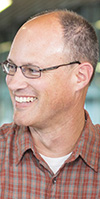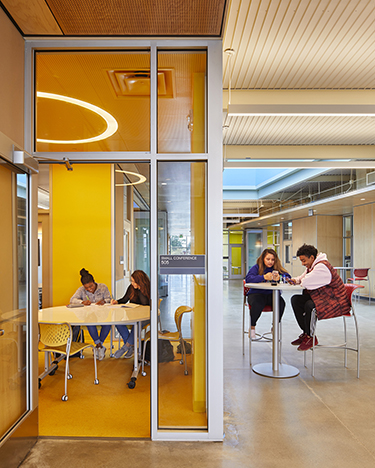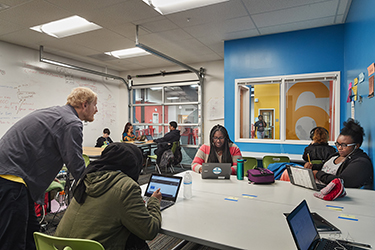|
Subscribe / Renew |
|
|
Contact Us |
|
| ► Subscribe to our Free Weekly Newsletter | |
| home | Welcome, sign in or click here to subscribe. | login |
Construction
| |
 |
August 24, 2017
2 new buildings that push students to become more engaged learners
NAC Architecture

Riedel
|
Imagine a school where, instead of sitting in rows listening to a teacher, students are clustered around a whiteboard solving an engineering problem, or around a table outlining a group presentation. They are concentrating and working together.
This is called active learning, simply defined by researchers Charles Bonwell and Jim Eison as “involving students in doing things and thinking about the things they are doing.”
Now envision the buildings, spaces and furnishings that support this style of learning: facilities that are inviting, flexible and student-centered.
Active learning
As educators look for effective ways to engage and prepare students for today’s world, many of the best are finding that active learning techniques provide a critical connection between the students, the material and the tools that will help them succeed: collaboration, creativity and critical thinking.
Active learning involves students in their own education. It encourages tinkering, problem solving, asking questions, discussing, writing, presenting and other activities in service to the lesson.
These are not new educational techniques, but as their combined effectiveness is becoming realized, their implementation becomes more widespread. When students actively participate and feel ownership of their education, they become lifelong learners with the cognitive skills needed to thrive in a changing world.
As educators continue to integrate active learning into their curriculum, the way we design schools is changing. An educational space that inspires learning and cultivates collaboration encourages less lecturing and puts an emphasis on student participation. Students are in turn far more engaged and more apt to retain information.
So what do these schools look like? Two Western Washington high schools — Wilson High School in Tacoma and Summit Sierra in Seattle — are both optimized to accommodate active learning.
Wilson High School
Tacoma Public Schools has been recognized by the state Office of the Superintendent of Public Instruction as an “innovation zone” that provides a varied portfolio of educational choices to their students, supported by a strong infrastructure to promote ongoing innovation initiatives.
The continuing academic success of Wilson High School has demonstrated the effectiveness of this approach. Under the leadership of Principal Dan Besett, Wilson has won a statewide “school of distinction” award six years in a row.
During design of Wilson’s new academic building, an array of learning space arrangements were presented and reviewed with the teachers, ranging from traditional closed classrooms to flexible open environments.
The design for the academic building includes a lot of flexibility, allowing teachers to easily reconfigure an open learning environment into areas that support small-group work when appropriate. Classroom-sized spaces that accommodate up to 30 students feature opaque operable partitions that can be opened to a flexible common space to support team teaching or even larger group activities.
A large, informal “learning stair” can be used by individuals, small groups and large groups of up to 75 people. Colorful small breakout rooms accommodate groups of two to six people working together, acoustically separate but with plenty of visibility to other areas.
Large markerboard panel walls and mobile touchscreen displays are located throughout the building to facilitate spontaneous group work and presentations. Flexible furniture can be easily reconfigured and soft seating in collaborative areas encourages informal learning and discussions.
Summit Sierra
Summit Sierra, located in Seattle’s Little Saigon neighborhood, is a high school operated by the nonprofit Summit Public Schools.
Summit’s educational program focuses on high-impact teaching that personalizes learning for every student. Through project-based learning, Summit educators help students develop the cognitive skills needed to succeed. Their new facility is an adaptive reuse of a pre-engineered metal building where the infill was maximized to create a variety of flexible educational spaces and lots of open learning area.
The self-paced, student-directed learning is supported by the openness and flexibility of the learning spaces. Similar to Wilson High School, seminar rooms open onto the larger collaborative space, and smaller quiet rooms are available for individuals to concentrate or small groups to discuss projects.
Glass garage doors provide transparency and flexibility between the seminar rooms and open learning areas. Whiteboard paint was used to turn wall surfaces into working surfaces, and even the windows are used as markerboards. Laptops are plugged into projectors on carts, which can be pointed at any wall to display content.
The school was intentionally designed to spark creativity and support impromptu collaboration everywhere, allowing students to take control of their education.
Rethinking school spaces
Active learning is a pedagogical strategy based on our growing understanding of the value that a collaborative, project-based curriculum provides. Studies show that active learning encourages student engagement, builds self-esteem and ownership of learning, and creates a sense of community in the classroom through collaboration and partnership.
Designing a new school building is an opportunity to rethink traditional programming and create a facility that supports the important educational work that the students and teachers are doing, both now and into the future.
Rather than limit educational delivery, architecture must get out of the way, providing the right combination of connection, separation and flexibility to accommodate a large variety of educational activities. When it is done right, it can help empower young people to realize their own futures.
Malia Burns, executive director at Summit Sierra, describes the vision that drove the design of their new school: “What kind of thinking do we want our students doing? What kind of collaborating do we need to be doing? How can they make choices about how they are using their space based on what their learning needs are?
“Our hope is that by senior year our students are able to do a lot more of that decision making for themselves, very thoughtfully and strategically aligned with their learning goals.”
Philip Riedel is a principal at NAC Architecture who has spent the last 18 years researching and creating innovative pre-kindergarten-12 learning environments. Riedel was recently appointed the 2017 president-elect by the Association for Learning Environments, Pacific Northwest Region.
Other Stories:
- Giant murals give students ‘something to look at and feel proud’
- Seattle’s Lincoln High to reopen 38 years after closing
- Outdoor learning labs let children connect to nature
- Tahoma High project makes the best of a hilly site on former golf course
- North Seattle elementary supports students by opening its doors to families
- Designers study Tinkertoy-inspired school 20 years later to see what worked
- High schoolers get real-life work experience in health sciences building
- Classroom wing provides West Sound’s first new STEM space
- Why an old church could make a good place for a charter school




